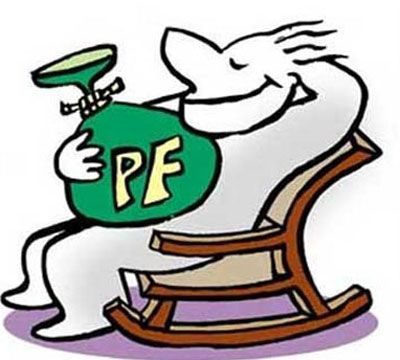
'The rate of interest from the EPF is still attractive compared to the rates on fixed deposits, National Savings Scheme, Public Provident Fund...' report Joydeep Ghosh and Sanjay Kumar Singh.
Illustration: Uttam Ghosh/Rediff.com
The Employees Provident Fund Organisation (EPFO)'s decision to cut the interest rate from 8.8% to 8.65% for 2016-2017 should not come as a surprise to investors.
With interest rates heading southwards, this move was expected.
Already, the yield on the government's 10-year benchmark has slipped to 6.51%.
In addition, the small 5% of the incremental corpus' exposure to equities has not yielded great returns as the Bombay Stock Exchange Sensitive Index, or S&P Sensex, is up barely 3.3% in the past year.
Also, such a small exposure can barely offset overall returns.
"The rate of interest from the EPF is still attractive compared to the rates on fixed deposits, National Savings Scheme, Public Provident Fund, and so on," says Rakesh Bhargava, director, Taxmann.
If one considers the rate of return, which the State Bank of India, the country's largest lender, is offering, EPF rates look excellent.
Sample this: SBI is offering 7% on its one-year fixed deposits and 6.5% for 5- to 10-year tenure.
The gap between EPFO and SBI's one-and 10-year rates currently stand at a good 165 and 205 basis points -- something which will translate into a significant amount over the longer term.
If an investor puts Rs 10,000 a month in EPF at 8.65% interest instead of 8.8%, returns would be lower by only Rs 180.
Even if this rate persists for the next 10 years, the difference would be merely Rs 3,822.
In comparison, investing the same amount in a one-year SBI fixed deposit would fetch only Rs 8,400.
The Senior Citizens Saving Scheme (SCSS) gives a return of 8.5%, which is taxable.
The Public Provident Fund rate is also tax-free, but it has already come down to 8%.
The falling interest on debt instruments has experts advising that people making voluntary contribution, over and above the compulsory deduction, should continue to do so.
"Any person who makes an additional voluntary contribution, over and above the mandatory contribution of 12%, should continue with that contribution at this point of time," says Manoj Nagpal, chief executive officer, Outlook Asia Capital.
If your employer gives the choice of investing either in EPF or the National Pension Scheme (NPS), investors may consider shifting to the latter.
The latter offers the potential to earn higher returns, since a higher proportion of the corpus can be invested in equities (as high as 75%).
However, the EET (exempt-exempt-taxation) status has played a spoilsport in case of the NPS.
"Also, a part of the final corpus will have to be invested in annuities. Returns from annuities are not very attractive. If you decide to shift to NPS, choose a debt-to-equity ratio that is in keeping with your age and risk profile,” adds Nagpal.
Debt funds can be a good option. And they have been a positive surprise this year as falling interest rates have given a spike to bond prices.
For example: Gilt medium-and long-term and dynamic bond funds have returned 16.36% and 14.07% in the past year, respectively.
Before you jump to invest aggressively in debt funds, remember that they are riskier in nature.
If you planning to make fresh allocation to debt, debt funds are a good option.
Why EPFO cut interest rate
Cutting the interest rate by 0.15% means the EPFO will have a surplus of Rs 250 crore.
Arindam Majumder reports.
40 million subscribers will get a four-year low interest rate of 8.65% on their money in Employees Provident Fund for the current financial year, against 8.8% they received in 2015-2016.
The highest decision-making body, theCentral Board of Trustees (CBT), of the Employees Provident Fund Organisation (EPFO) took the decision at a meeting in Bengaluru despite objections raised by the trade unions.
The decision by the body to cut interest rate was taken in light of low surplus and the finance ministry's aim of lowering interest rates on other saving schemes.
EPFO's financial audit and investment committee (FIAC) had recommended a similar cut in the interest rate as the body's surplus was not enough to pay an interest rate of 8.8% as demanded by the trade unions.
According to sources in the labour ministry, FIAC said that continuing with an 8.8% rate this financial year will leave EPFO with a deficit of around Rs 394 crore (Rs 3.94 billion), while with an interest rate of 8.65%, the body will be left with a surplus of around Rs 250 crore (Rs 2.5 billion).
FIAC preliminary estimates show that EPFO's total corpus will stand at around Rs 39,000 crore (Rs 39 billion) for 2016-2017.
However, trade union members argued that FIAC has not taken into consideration the interest it will earn from the investment in equities.
In September, EPFO hiked its exposure to equities to 10% of the total corpus from the previous 5%.
"We tried to impress on the minister that if the income from exchange-traded fund is added, then an 8.8% rate will not result in deficit," said D L Sachdev, general secretary, All India Trade Union Congress.
While there was a demand by most trade unions to continue with the 8.8% rate for this financial year, the government seems to have taken the largest trade union, the Bharatiya Mazdoor Sangh, on board.
Virjesh Upadhyay, secretary, BMS, said that a cut in the interest rate was in line with falling interest rate worldwide.
"Despite a cut, EPFO is still the most attractive savings scheme with a higher interest rate than any other savings scheme in the country," Upadhyay told Business Standard.
A senior labour ministry official said the decision was also in line with other small savings scheme -- interest rates which have been cut by the finance ministry as these are now market-linked and yield of government securities with equivalent maturities depleted -- and other saving instruments in the market.
"The finance ministry has cut the interest rate on PPF (public provident fund). EPFO cannot have interest rate in isolation," the official said.
According to the practice, the finance ministry gives concurrence to the rate of interest fixed by the CBT, considering the income projections of a year.
After its ratification, the interest rate is notified and credited into the accounts of subscribers.
However, CBT and the finance ministry differed over the interest rates for 2015-2016 when North Block cut the interest rate to 8.7% against the former's recommendation of 8.8%.
Later, the ministry relented, after protests by the unions.
Ashish Shanker, head investment advisory Motilal Oswal Pvt Wealth Management, raises questions about one's retirement funds keeping pace with high inflation.
"With interest rates being where they are and inflation continuously threatening to erode the value of money, one needs to ask a broader question for a portfolio that confines itself predominantly to debt instruments," he said.
"How safe is one's retirement money?" he asked.












 © 2025
© 2025